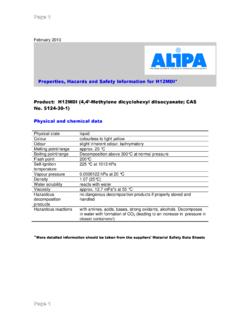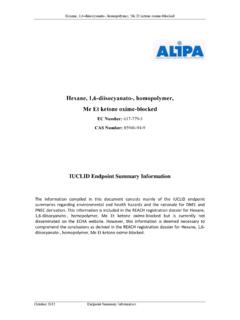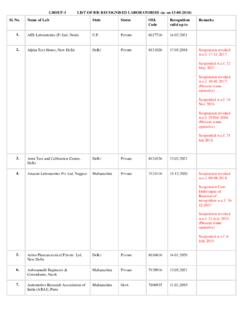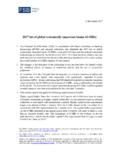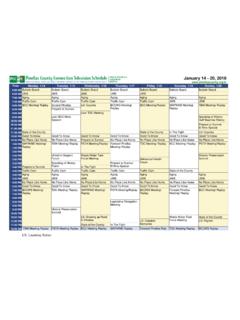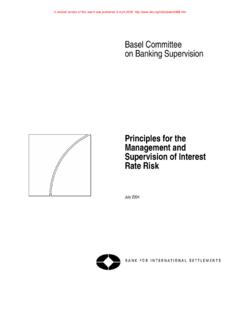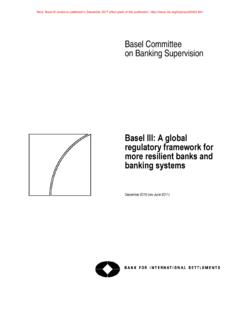Transcription of SIDS Initial Assessment Report For SIAM 20 - ALIPA
1 OECD sids 4,4 -METHYLENEDICYCLOHEXYL DIISOCYANATE 1 sids Initial Assessment Report For siam 20 Paris, France, 19-22 April 2005 1. Chemical Name: 4,4 -Methylenedicyclohexyl diisocyanate 2. CAS Number: 5124-30-1 3. Sponsor Country: Contact Point: BMU (Bundesministerium f r Umwelt, Naturschutz und Reaktorsicherheit) Contact person: Prof. Dr. Ulrich Schlottmann Postfach 12 06 29 D- 53048 Bonn4. Shared Partnership with: - 5. Roles/Responsibilities of the Partners: - Name of industry sponsor /consortium Bayer AG, Germany Contact person: Dr. Burkhardt Stock D-51368 Leverkusen Geb ude 9115 Process used OECD/ICCA - The BUA Peer Review Process: see next page 6. Sponsorship History How was the chemical or category brought into the OECD HPV Chemicals Programme ? by ICCA-Initiative 7. Review Process Prior to the siam : last literature search (update): 4 October 2004 (Human Health): databases medline, toxline; search profile CAS-No.
2 And special search terms 8 November 2004 (Ecotoxicology): databases CA, biosis; search profile CAS-No. and special search terms OECD/ICCA 8. Quality check process: IUCLID was used as a basis for the sids dossier. All data were checked and validated by BUA. A final evaluation of the human health part has been performed by the Federal Institute for Risk Assessment (BfR) and of the ecotoxicological part by the Federal Environment Agency (UBA). 9. Date of Submission: Deadline for circulation: 21 January 2005 10. Date of last Update: Last literature search: IUCLID Chapters 1-4: 2003-08-13, Chapter 2004-07-27, Chapter 5: 2003-01-22; OECD sids 4,4 -METHYLENEDICYCLOHEXYL DIISOCYANATE 2 11. Comments: OECD/ICCA - The BUA* Peer Review Process Qualified BUA personnel (toxicologists, ecotoxicologists) perform a quality control on the full sids dossier submitted by industry.
3 This quality control process follows internal BUA guidelines/instructions for the OECD/ICCA peer review process and includes: a full (or update) literature search to verify completeness of data provided by industry in the IUCLID/HEDSET Review of data and Assessment of the quality of data Review of data evaluation Check of adequacy of selection process for key studies for OECD endpoints, and, where relevant, for non-OECD endpoints by checking original reports/publications Review of key study description according robust summaries requirements; completeness and correctness is checked against original reports/publications(if original reports are missing: reliability (4), reliability not assignable) Review o f validity of structure-activity relationships Review of full sids dossier (including SIAR, SIAP and proposal for conclusion and recommendation for further work) In case of data gaps, review of testing plan or rationale for not testing * BUA (GDCh-Beratergremium f r Altstoffe): Advisory Committee on Existing Chemicals of the Association of German Chemists (GDCh) OECD sids 4,4 -METHYLENEDICYCLOHEXYL DIISOCYANATE 3 sids Initial Assessment PROFILE CAS No.
4 5124-30-1 Chemical Name 4,4 -Methylenedicyclohexyl diisocyanate Structural Formula NCONCO SUMMARY CONCLUSIONS OF THE SIAR Human Health 4,4 -Methylenedicyclohexyl diisocyanate is of low oral and dermal acute toxicity with an oral LD50 (rat) of 9900 mg/kg bw and a dermal LD50 (rabbit) > 10,000 mg/kg. Toxic symptoms after oral administration included severe diarrhea, loss of appetite and increasing weakness. Assessment of the acute inhalation toxicity data indicates that exposure to respirable aerosols of 4,4 -methylenedicyclohexyl diisocyanate confined predominantly to the respiratory tract. Clinical signs (salivation, bradypnea, stridor) indicated respiratory distress. A haemorrhagic lung edema was considered to be causative for mortality.
5 An animal study according to OECD TG 403 gives a LC50 (4 h, rat) of 434 mg/m3. 4,4 -Methylenedicyclohexyl diisocyanate is moderately to severely irritant to the skin of rabbits (OECD TG 404). Irritant effects were observed after instillation of 4,4 -methylenedicyclohexyl diisocyanate into the eyes of rabbits (OECD TG 405). The repeated dose studies indicate that 4,4 -methylenedicyclohexyl diisocyanate causes irritation of the respiratory tract. Animal data are not uniform however they frequently provide evidence of a skin sensitizing potential of 4,4 -methylenedicyclohexyl diisocyanate. Human case reports describe allergic contact dermatitis due to 4,4 -methylenedicyclohexyl diisocyanate exposure. Although no validated animal model is available to assess the potential for respiratory sensitization or asthma in humans animal data support to some extent the hypothesis that respiratory hypersensitivity may be induced by 4,4 -methylenedicyclohexyl diisocyanate.
6 No results from repeated-dose toxicity tests are available for the oral and dermal route of exposure. A subacute inhalation study (1, 6 and 36 mg/m3; 6 hours/day on five days/week for 4 weeks) with rats (OECD TG 412) indicates the respiratory tract to be the target organ of respirable 4,4 -methylenedicyclohexyl diisocyanate aerosol. The reported NOAEL for effects governed by respiratory tract irritation is 1 mg/m3; the LOAEL is 6 mg/m3 ( histopathological changes in nasal passages, larynx and bronchi). The results of a reproduction/developmental toxicity screening test (OECD TG 421) corresponds to the results of the subacute study. 4,4 -Methylenedicyclohexyl diisocyanate did not induce gene mutations in bacteria (OECD TG 471) and demonstrated no potential to induce chromosome aberrations in Chinese hamster V79 cells in vitro (OECD TG 473) either with or without metabolic activation.
7 Data from an inhalative reproduction/developmental toxicity screening test according to OECD TG 421 with rats (1, 6 and 36 mg/m3) did not reveal substance related impairment of reproduction up to a 4,4 -methylenedicyclohexyl diisocyanate concentration of 6 mg/m3. A slightly reduced fertility index was observed at an exposure level (36 mg/m3) that was associated with parental toxicity. NOAELs were considered to be 1 mg/m3 in males and females for general toxicity. NOAEL for reproductive toxicity is 6 mg/m3. Pre-natal inhalation toxicity testing in rats (OECD TG 421) indicates the absence of selective toxicity to the development at levels up to 36 mg/m3. No findings indicate any specific developmental effects such as live birth index, viability index and apparent malformation.
8 The reported NOAEL(developmental) for 4,4 -methylenedicyclohexyl diisocyanate in a developmental toxicity study according to OECD TG 414 (1, 6 and OECD sids 4,4 -METHYLENEDICYCLOHEXYL DIISOCYANATE 4 36 mg/m3) is 6 mg/m3/day. At the 36 mg/m3 level that caused clear maternal respiratory tract toxicity (NOAEL(maternal) = 1 mg/m3) increased incidences of ventricular septal defects of the heart and slight dilation of lateral brain ventricles were observed, which lay marginally above the upper or within the normal range of scattering of the rat strain used respectively. Environment 4,4 -Methylenedicyclohexyl diisocyanate is a slightly yellowish, moisture/water sensitive liquid with a melting point of 15 C. 4,4 -Methylenedicyclohexyl diisocyanate has a relative density of at 25 C, a boiling point of 167 - 168 C (at 2 hPa), and a vapor pressure of x 10-5 hPa at 25 C [Directive 92/69/EEC, ].
9 A water solubility and a log KOW are not determinable due to the instability of 4,4 -methylenedicyclohexyl diisocyanate in water. The flash point of 4,4 -methylenedicyclohexyl diisocyanate is 200 C [DIN 51758], the ignition point is 225 C and the viscosity is approximately 30 mPa x s at 25 C [DIN ISO EN 3219 ]. The calculated half-life of 4,4 -methylenedicyclohexyl diisocyanate in air due to indirect photodegradation is about h. 4,4 -Methylenedicyclohexyl diisocyanate hydrolyses rapidly in the presence of water, the major product in the aqueous phase is methylene bis(4-cyclohexylamine). In water, a half-life for 4,4 -methylenedicyclohexyl diisocyanate of approximately 2 hours was determined experimentally. Due to the rapid hydrolysis of 4,4 -methylenedicyclohexyl diisocyanate, a transport of the substance between environmental compartments is unlikely.
10 Consequently, a calculation of the Henry Law Constant and of the distribution between the environmental compartments according to the Mackay fugacity model level 1 is not suitable. However, several aquatic toxicity tests have been undertaken with 4,4 -methylenedicyclohexyl diisocyanate and its hydrolysis products. Because of the rapid hydrolysis the Assessment of the substance should be based on the hydrolysis products and not on 4,4 -methylenedicyclohexyl diisocyanate. The hydrolysis product methylenebis-p-cyclohexylamine was assessed by the EU PBT Working Group. The hydrolysis product was not classified as a PBT substance. 4,4 -Methylenedicyclohexyl diisocyanate is not readily biodegradable. Due to the rapid hydrolysis 4,4 -methylenedicyclohexyl diisocyanate is neither persistent in the water compartment nor bioaccumulative.
